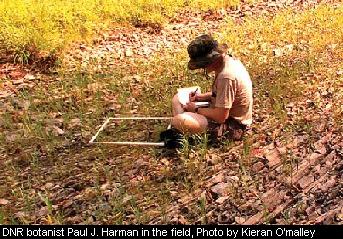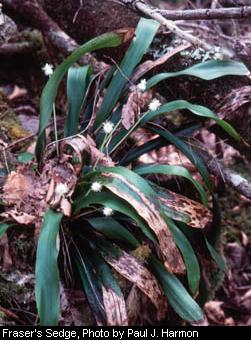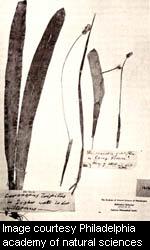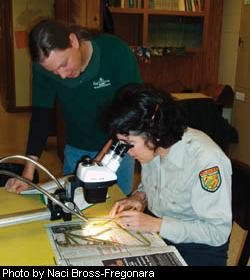The Plant
Collectors
By Paul J. Harmon
 In every land, in every culture, humans
have needed someone who could identify the plants around them. In the
Gahuku of New Guinea, it may have been a shaman. Among the Lakota of the
North American plains, it may have been a wise grandmother. Someone in
each culture collected plants, brought them back to the tribe, and shared
them. In the hills of Wayne County, West Virginia, where I was born, older
folks in our community knew about ramps, sassafras and wild ginger. They
knew what kind of wood was the best for fires, fences or building and
how to avoid poison ivy and jimson weed. In every land, in every culture, humans
have needed someone who could identify the plants around them. In the
Gahuku of New Guinea, it may have been a shaman. Among the Lakota of the
North American plains, it may have been a wise grandmother. Someone in
each culture collected plants, brought them back to the tribe, and shared
them. In the hills of Wayne County, West Virginia, where I was born, older
folks in our community knew about ramps, sassafras and wild ginger. They
knew what kind of wood was the best for fires, fences or building and
how to avoid poison ivy and jimson weed.
As societies became more sophisticated, plant collectors changed from
herb-toting shamans to professional field botanists. I am a conservation
botanist of the 21st century, yet I go to the woods, meadows and creek
banks to collect plants and carefully document the plant’s name,
where it was growing, and with which other plants. I write the date that
I collect the plant in Write-in-the-Rain® notebooks and record their
precise location using a GPS unit or map. I note field observations about
the plant that might not be evident once the specimen has been flattened
between newspaper and cardboard, dried, glued to an acid-free sheet of
paper, and filed in a folder in an insect-proof case.
Why on earth would one go to so much trouble to preserve specimens of
plants? Because a museum-like collection of dried, pressed plant specimens,
or herbarium, is a critical resource to conservation botanists. Properly
maintained collections are a permanent source of helpful information to
those who need to confirm plant identification, distribution, flowering
and fruiting time, and more. Biologists also use herbaria to verify the
identity of seeds found in the crop of a grouse, or scraps of leaves and
flowers in the stomach of a bear. Herbaria also serve as teaching aids,
and botanical illustrators often work from herbarium specimens when fresh
plants are not available.
Plant collecting sprung to life in North America in the late 18th century
as word spread quickly in Europe that the New World was not only becoming
more accessible, but home to plants never before seen by botanists. According
to Wendell Boone in his History of Botany in West Virginia, wealthy patrons
of that period were quick to send trained botanists to search for new,
unusual and useful plants.
Matthias Kin, a German nurseryman
who lived in Germantown, Pennsylvania collected mostly living plants and
seeds for horticultural purposes, pressing some plants for herbarium specimens.
Many of his collections were sent to the Berlin Botanical Garden herbarium
in Germany where they were presumably destroyed by a bomb in World War
II.
 Fortunately, duplicate specimens are still
housed in the herbarium of the Philadelphia Academy of Natural Sciences,
a key center for scientific research in Kin’s day. One can still
find the specimen Kin collected in about 1800 of the plant he called the
Latin name Coronopus tripitus. Thomas Nuttall later decided that
this was really a sedge, and called it Carex fraseri (Fraser’s
sedge). Recently, we learned that Kin’s plant is really Cymophyllus
fraserianus. These changes were not just name changes, but new understandings
into which genus this rare plant belonged.
On the faded label, in Kin’s handwriting was scrawled, “Deigher
walli in der wilternus,” which was later interpreted to mean
“Tygart Valley in the wilderness.” It took more than 150 years
for botanists to document Fraser’s sedge again in Tygart Valley.
Confirmation of this discovery in 1963 depended upon specimens held in
herbaria. Fortunately, duplicate specimens are still
housed in the herbarium of the Philadelphia Academy of Natural Sciences,
a key center for scientific research in Kin’s day. One can still
find the specimen Kin collected in about 1800 of the plant he called the
Latin name Coronopus tripitus. Thomas Nuttall later decided that
this was really a sedge, and called it Carex fraseri (Fraser’s
sedge). Recently, we learned that Kin’s plant is really Cymophyllus
fraserianus. These changes were not just name changes, but new understandings
into which genus this rare plant belonged.
On the faded label, in Kin’s handwriting was scrawled, “Deigher
walli in der wilternus,” which was later interpreted to mean
“Tygart Valley in the wilderness.” It took more than 150 years
for botanists to document Fraser’s sedge again in Tygart Valley.
Confirmation of this discovery in 1963 depended upon specimens held in
herbaria.
In time, researchers collected and verified specimens of Fraser’s
sedge from 11 mountainous counties of West Virginia, resulting in the
re-evaluation of the species rarity. We now can spend less time on Fraser’s
sedge and concentrate on rarer species, such as the small whorled pogonia
orchid. We still track Fraser’s sedge but no longer consider it
“extremely rare and critically imperiled.”
Thus herbarium specimens like Kin’s are very important to conserving
plants. They provide historical documentation of the status of the state’s
plant life. Plants not only have their own intrinsic value, but as part
of our natural inheritance, they are sources of food, building materials,
shelter and cover for animal species. Photosynthetic plants, as the receivers
of sunlight and producers of food, interact with insects, mammals, fungi,
bacteria and other organisms to fuel life on our planet. With the diversity
of plant species go the diversity of animals and natural communities.
 Recognizing this importance, curators of herbaria at West Virginia University,
Marshall University, Davis and Elkins College, Youngstown State University
in Ohio, and the Carnegie Museum of Natural History in Pittsburgh have
worked cooperatively with the DNR’s Natural Heritage Program botanists
and members of the Flora West Virginia Committee, to enter approximately
86,000 specimen label data into the Curatorial Database System (CDS).
This is then used to generate checklists and county dot map atlases of
vascular plants, bryophytes (mosses, liverworts and hornworts) and macro-fungi
(mushrooms). Recognizing this importance, curators of herbaria at West Virginia University,
Marshall University, Davis and Elkins College, Youngstown State University
in Ohio, and the Carnegie Museum of Natural History in Pittsburgh have
worked cooperatively with the DNR’s Natural Heritage Program botanists
and members of the Flora West Virginia Committee, to enter approximately
86,000 specimen label data into the Curatorial Database System (CDS).
This is then used to generate checklists and county dot map atlases of
vascular plants, bryophytes (mosses, liverworts and hornworts) and macro-fungi
(mushrooms).
The resulting distributional data, as well as habitat, associated plant
species, and flowering time (phenology), help botanists chart where species
grow, when they can be found in bloom or seed, and where else they are
likely to be growing.
Through this atlas project, 5,373 records of rare plants tracked by The
Natural Heritage Program were captured. DNR staff are reviewing that data,
comparing it to existing records in our system, and updating it when appropriate.
None of it would be available or useful were it not for plant collectors,
plant taxonomists, herbarium curators and those specimens in herbaria.
Of all the plant collectors who have contributed to the atlas project,
none have collected more specimens than Bill Grafton, a forester and a
wildlife specialist with the WVU Extension Service. Just examining the
portion of the WVU herbarium specimens entered into the CDS to date, it
became clear to me that heavy hitting collectors like C. F. Millspaugh,
L. W. Nuttall, P. D. Strausbaugh, Earl L. Core, Betty Bartholomew, and
the Botanical Expeditions of the 1920s and ‘30s, together total
9,632 records. But Grafton’s collections total 14,773 records! Grafton
believes strongly in the worth of all the time and trouble of plant collecting.
Paraphrasing the Roman philosopher Cicero, he says “There’s
nothing so absurd but that there is not a champion.”
Grafton himself has been the champion in West Virginia for plant collecting.
He once nearly lost his life while collecting on the edge of the New River
Gorge when melting ice and snow gave way under his feet. A sapling within
his reach permitted him to haul himself up from the chasm. Another time,
he found himself chased by a bear from a spiraea thicket in Canaan Valley. “The only thing that saved me was standing up as tall as I could
and waving two white collecting bags over my head and speaking sternly,” he recalls! Perhaps the most remarkable testimony to the character of
this field botanist is the endless hours he has spent in solitude sorting,
identifying, arranging, labeling and pressing thousands of plant specimens.
Unfortunately, Grafton and other plant collectors seem like a dying breed.
While there has been an increase in awareness of the need to conserve
natural resources, there’s been a sharp decline in the support for
plant collections. Worse, there has been a sharp decline in field botany
training available on college campuses. Most biology departments no longer
recognize floristic studies as legitimate thesis projects, resulting in
fewer graduating biologists who can identify common, much less rare, flora.
It seems that support for field biology goes up and down in a cyclic manner
with background and training of biology department administrators. Collections
throughout the nation have become recently threatened with ‘extinction,’ and a few have actually had their doors closed and their specimens boxed
and stored or shipped to herbaria outside their states. In 2003, Iowa
and Nebraska lost their facilities, but since then, the national uproar
of opposition to the closing of collections may have quieted the call
for closings.
Today, the herbarium at WVU has moved its 180,000 plus specimens to the
new Life Sciences Building, into smaller but more efficient facilities.
Support for the state herbarium and its curator, Dr. Donna Ford-Werntz,
is currently strong with good research taking place. Marshall University’s
herbarium houses more than 50,000 specimens of vascular plants, and more
than 5,000 bryophytes. The next largest herbarium at West Virginia Wesleyan
is home to more than 30,000 vascular plants. What would happen if those
collections were given away to an institution outside West Virginia? What
a tragic loss that would be for the conservation of natural resources
in West Virginia.
The real threat to herbaria is ignorance about their purpose and value,
and competition for space on campuses. Herbaria do not cost a lot of money
to maintain, compared to the huge budgets of other research facilities
on university campuses. However, the value of herbaria as critical conservation
tools is immeasurable and there must be continued support to keep the
work of plant collectors, past and present, safe, updated and available
for use in West Virginia.
Natural historians of the 18th and 19th centuries were visionaries who
valued natural diversity. Like those pioneers, modern-day field biologists
understand that collections of all kinds--plants, mammals, insects, mosses,
fungi, reptiles and rocks – all are not just groups of historical
relicts, but research tools that must have constant infusions of fresh
material, fresh information and fresh annotations by trained scientists.
We must continuously re-examine collections to apply new insights about
our natural heritage. As noted ecologist Baba Dioum once said, “In
the end we will conserve only what we love. We love only what we understand.
We will understand only what we are taught.”
Paul J. Harmon is the Natural Heritage botanist stationed in Elkins.
Saving Our Plant Heritage
 DNR biologist Sam Norris has written a small, concise handbook to creating,
managing and using plant collections. In it, he not only provides pointers
about how to use an herbarium without damage to the fragile specimens,
but offers suggestions on collecting plants for deposit in herbaria. “Thoughtful
collecting is an excellent way to gain familiarity with wild plants, and
it is good outdoor sport,” he says, “A herbarium specimen
represents a considerable investment in labor, materials and overhead
by the time it is filed in the collection. It only makes sense to maximize
its value by collecting the best possible specimen and making reasonably
complete notes to accompany it.” DNR biologist Sam Norris has written a small, concise handbook to creating,
managing and using plant collections. In it, he not only provides pointers
about how to use an herbarium without damage to the fragile specimens,
but offers suggestions on collecting plants for deposit in herbaria. “Thoughtful
collecting is an excellent way to gain familiarity with wild plants, and
it is good outdoor sport,” he says, “A herbarium specimen
represents a considerable investment in labor, materials and overhead
by the time it is filed in the collection. It only makes sense to maximize
its value by collecting the best possible specimen and making reasonably
complete notes to accompany it.”
If you suspect a plant is rare, consider taking a photograph instead of
a specimen. For rare plants, don’t collect the entire plant, and
as a rule, do not collect from small populations. The Plant Conservation
Roundtable’s Conservation Guidelines (1986) is available
from the West Virginia Natural Heritage Program. In it, the authors advise
that when it is essential to verify a new record with a voucher, collect
only a single specimen, and don’t collect the whole plant when plant
parts would be sufficient.
|


 In every land, in every culture, humans
have needed someone who could identify the plants around them. In the
Gahuku of New Guinea, it may have been a shaman. Among the Lakota of the
North American plains, it may have been a wise grandmother. Someone in
each culture collected plants, brought them back to the tribe, and shared
them. In the hills of Wayne County, West Virginia, where I was born, older
folks in our community knew about ramps, sassafras and wild ginger. They
knew what kind of wood was the best for fires, fences or building and
how to avoid poison ivy and jimson weed.
In every land, in every culture, humans
have needed someone who could identify the plants around them. In the
Gahuku of New Guinea, it may have been a shaman. Among the Lakota of the
North American plains, it may have been a wise grandmother. Someone in
each culture collected plants, brought them back to the tribe, and shared
them. In the hills of Wayne County, West Virginia, where I was born, older
folks in our community knew about ramps, sassafras and wild ginger. They
knew what kind of wood was the best for fires, fences or building and
how to avoid poison ivy and jimson weed. Recognizing this importance, curators of herbaria at West Virginia University,
Marshall University, Davis and Elkins College, Youngstown State University
in Ohio, and the Carnegie Museum of Natural History in Pittsburgh have
worked cooperatively with the DNR’s Natural Heritage Program botanists
and members of the Flora West Virginia Committee, to enter approximately
86,000 specimen label data into the Curatorial Database System (CDS).
This is then used to generate checklists and county dot map atlases of
vascular plants, bryophytes (mosses, liverworts and hornworts) and macro-fungi
(mushrooms).
Recognizing this importance, curators of herbaria at West Virginia University,
Marshall University, Davis and Elkins College, Youngstown State University
in Ohio, and the Carnegie Museum of Natural History in Pittsburgh have
worked cooperatively with the DNR’s Natural Heritage Program botanists
and members of the Flora West Virginia Committee, to enter approximately
86,000 specimen label data into the Curatorial Database System (CDS).
This is then used to generate checklists and county dot map atlases of
vascular plants, bryophytes (mosses, liverworts and hornworts) and macro-fungi
(mushrooms).